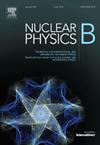Investigating the H0 − rd tension in f(R,T) gravity using cosmological observations
IF 2.5
3区 物理与天体物理
Q2 PHYSICS, PARTICLES & FIELDS
引用次数: 0
Abstract
The ongoing Hubble tension, a significant discrepancy between early- and late-universe measurements of the Hubble constant , challenges the foundations of modern cosmology. A closely related issue, the tension, arises from the dependency of BAO-based inferences of on the assumed sound horizon at the drag epoch . In this work, we investigate the cosmological implications of the gravity model, which introduces a direct coupling between the Ricci scalar (R) and the trace of the energy-momentum tensor (T). By utilizing a Markov Chain Monte Carlo (MCMC) analysis with observational datasets, such as Baryon Acoustic Oscillations (BAO), Cosmic Chronometers (CC), and Standard Candles (SC), we constrain the model parameters and assess their compatibility with current cosmological observations. Our findings indicate a strong correlation between and , confirming that different dataset combinations lead to systematically varying constraints on these parameters. The inclusion of the Riess 2019 prior (R19) results in higher values of , reinforcing the Hubble tension, while BAO-only data favors lower values, consistent with early-universe measurements. Additionally, we analyze the evolution of the main cosmologic parameters such as the deceleration parameter and the equation of state parameter . Our results suggest that the model exhibits a quintessence-like behavior, with at present, indicating a dynamical dark energy component rather than a simple cosmological constant. Furthermore, we confirm that the present-day values of the matter and dark energy density parameters, and , remain consistent with a spatially flat universe. These results highlight the role of modified gravity in addressing key tensions in cosmology and demonstrate that the framework provides a natural extension of ΛCDM.
利用宇宙学观测研究f(R,T)引力中的H0 − rd张力
持续的哈勃张力,早期和晚期宇宙测量哈勃常数H0之间的显著差异,挑战了现代宇宙学的基础。另一个密切相关的问题是H0 - rd张力,这是由于基于bao的H0推论依赖于拖拉时期rd的假设声视界。在这项工作中,我们研究了f(R,T)=R+2λT引力模型的宇宙学意义,该模型引入了里奇标量(R)和能量动量张量(T)的迹线之间的直接耦合。通过对重子声学振荡(BAO)、宇宙天文钟(CC)和标准蜡烛(SC)等观测数据集的马尔可夫链蒙特卡罗(MCMC)分析,我们对模型参数进行了约束,并评估了它们与当前宇宙学观测的兼容性。我们的研究结果表明,H0和rd之间存在很强的相关性,证实了不同的数据集组合导致这些参数的约束条件系统地变化。包含Riess 2019先验(R19)导致更高的H0值,加强了哈勃张力,而仅bao数据倾向于较低的值,与早期宇宙测量一致。此外,我们还分析了减速参数q(z)和状态参数ω(z)方程等主要宇宙学参数的演化。我们的研究结果表明,f(R,T)模型表现出一种典型的行为,目前ω(z)>;−1表明一个动态暗能量成分,而不是一个简单的宇宙常数。此外,我们确认物质和暗能量密度参数的当前值Ωm≈0.3和ΩΛ≈0.7与空间平坦的宇宙保持一致。这些结果突出了修正引力在解决宇宙学中的关键张力方面的作用,并证明f(R,T)框架提供了ΛCDM的自然扩展。
本文章由计算机程序翻译,如有差异,请以英文原文为准。
求助全文
约1分钟内获得全文
求助全文
来源期刊

Nuclear Physics B
物理-物理:粒子与场物理
CiteScore
5.50
自引率
7.10%
发文量
302
审稿时长
1 months
期刊介绍:
Nuclear Physics B focuses on the domain of high energy physics, quantum field theory, statistical systems, and mathematical physics, and includes four main sections: high energy physics - phenomenology, high energy physics - theory, high energy physics - experiment, and quantum field theory, statistical systems, and mathematical physics. The emphasis is on original research papers (Frontiers Articles or Full Length Articles), but Review Articles are also welcome.
 求助内容:
求助内容: 应助结果提醒方式:
应助结果提醒方式:


